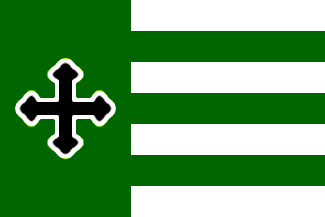
by Thanh-Tam Le , 12 Febuary 2000

Last modified: 2021-08-25 by rob raeside
Keywords: puerto rico | anasco |
Links: FOTW homepage |
search |
disclaimer and copyright |
write us |
mirrors

by Thanh-Tam Le , 12 Febuary 2000
See also:
The flag derives its design, colors and symbolism from the
municipal Coat of Arms. The only difference is that silver is
painted white on the flag.
Blas Delgado Ortiz, 6 April 2001
Name perhaps came from:
1) Asadist Spanish conqueror (perversion very frequent in the
conquerors) that massacred thousands of pacific natives until
that a Quishwa girl (previousely raped) with the help of some
survivors, murdered him. His name was Pedro de Añasco and
operate in Peru.
2) Other conqueror that operated in Florida in same era called
Juan de Añasco, originated from Sevilla.
But more probably is a name for "imbroglio" that is the
meaning of the name Añasco (Aramean orign I believe).
Jaume Ollé, 31 July 2001
an.gif)
by Nelson L. Román, 13 July 2004
The green field of the shield contains a saber cross massed in
black, outlined in silver, and has a gold scallop shell in each
quadrant formed by the cross. A gold mural crown of three towers
crests the shield. The shield itself is identical in its design
and colors to the one from which it probably came; that is, that
of Captain Luis de Añasco, companion of Captain Juan Ponce de
León in his first trip of exploration and colonization of Puerto
Rico. "When Juan Ponce de León came to discover Puerto
Rico," it is written in the "History of Puerto
Rico", by Fray Iñigo Abad y Lasierra, "he took in his
company Captain Luis de Añasco." The Cacique Agüebana
asked Juan Ponce de León to gave him the name of the captain,
which he used from there on. In his book "The Colonization
of Puerto Rico" Don Salvador Brau says that, "Luis de
Añasco resisted, with the help of other captains, the Indian
attack in Aguada (area of Añasco). The shield of the town of
Añasco is then, the same of the explorer Don Luis de Añasco,
whose last name is perpetual in the population. One of the
particular details, the four scallop shells, remember the last
name of the founder of Añasco, Don José de Santiago, because
these shells are also called "de Santiago", in the
Spanish tradition they represent Apostle Santiago el Mayor,
Patron of Spain.
Source: <www.linktopr.com>.
Nelson L. Román, 13 July 2004